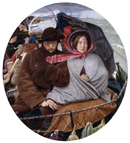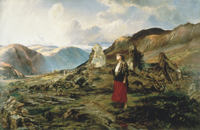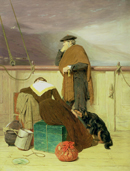
The story of Australia is the story of immigration. Museums in Melbourne and Adelaide and galleries elsewhere, like the Horizons gallery in the National Museum of Australia, have told two parts of the story: the convict period (1788-1868) and postwar European migration (1947-1975). The impact on Indigenous societies has been detailed in many venues and sources.
But strangely missing is often the most important formative period created through mass migration from the British Isles during the reign of Queen Victoria (1837-1901). Modern Australia was essentially a Victorian imperial creation. Those who created it came overwhelmingly from England, Ireland and Scotland and, to a lesser degree, from Wales and Cornwall. Certainly there were many others, especially Germans and Chinese, but their impact was limited, localised and, in the latter case, abruptly terminated.
This brilliant and evocative exhibition of contemporary artworks sticks tightly to its self-description. Although convict transportation lasted 30 years into Victoria's reign, this was mainly to Tasmania and Western Australia. By 1840 the south-eastern corner, then wholly within New South Wales, had ceased to take convicts. When the young queen came to the throne public funds were already being spent on bringing out suitable free immigrants, mainly from rural Britain and Ireland. This system in various forms continued from 1831 until 1983. Unlike the United States, at least half of all British immigrants in the Victorian period were deliberately selected and subsidised.

We are, then, spared the already well-worn convict images and details held mainly in the Mitchell and National libraries. Not a man is flogged or bound by chains. Drawing the line between convicts and the free is admittedly artificial. Many convicts soon gained their freedom, some prospered, some brought out their families and some even went back to the scene of their original crime. A few were transported more than once. But there is, quite rightly, no mention of this. The story being told is of the million-and-a-half who left the heartland of the world's largest and richest empire to settle at the end of the earth. Why did they come, who were they, how did they feel? Little is said about what happened to them. Nor are there portraits of those who became famous: Henry Parkes, Joseph Cook, Andrew Fisher, Billy Hughes, to mention only a few of the political leaders who arrived during Victoria's reign.
The greatest surge of emigration to Australia was in the 1850s and due to the lure of gold. Most paintings on display were produced during this decade. It was also the period when England and Scotland were becoming urban rather than rural societies and when Ireland was shattered and depopulated by the effects of the potato famine of the previous few years. Everywhere people were leaving the land. Despite some emphasis on the poverty of the major cities, the selection does not fall into the trap of showing emigration from the slums, prison and workhouses of the metropolis; these were the breeding grounds of the convicts, not of the assisted migrants. Regulations tried to ban those in workhouses or in habitual receipt of poor law assistance. Most poverty stricken city dwellers who reached Australia were sent by charities. The themes of rural poverty, Irish dispossession and the Scottish clearances were more attractive to Victorian artists and more sentimentally appealing to their public. I was especially struck by Hubert von Herkomer's 1885 painting Hard Times, showing an itinerant navvy and his wife and child. At this time my grandmother's father was just such a one: a navvy, railway fettler, farm labourer and eventually village chimney sweep. Two of his daughters worked in the notorious agricultural gangs of Fenland, made illegal in 1867.

Some outstanding works include The Last of England by Ford Madox Brown, Lochaber No More by John Watson Nicol, Lady Butler's Evicted and, of course, everyone's favourite, A Primrose from England by Edward William John Hopley. Works are grouped around themes, with a small but good selection of sailing ship portraits, pride of place being taken by the 'steam assisted' Great Britain. The passengers of Brunel's huge ship are claimed to be responsible for at least two per cent of Australia's current population, which may well be true. At the end comes Frederick McCubbin's triptych of 1904, The Pioneer. Hardship and sadness were not just the lot of the emigrant (as most other paintings suggest) but could equally strike the immigrant already settled in the colony. McCubbin is one of the few Australian-born artists here. Others, such as Charles Conder, Conrad Martens, Tom Roberts, and Eugène von Guérard, though born overseas, are regarded as Australian by adoption.
The exhibition catalogue is a significant work in its own right. Apart from the normal function of describing, reproducing and analysing each exhibit, it is almost the only comparably illustrated work on this major aspect of Australia's formative history. There are some controversial commentaries tending, like the exhibition itself, to overemphasise the poverty and desperation of immigrants, which was ceasing to be true for those from the English majority coming in the great boom of the 1880s. There are several incorrect dates, most notably for the birth of democracy at the Eureka Stockade. Like any artistic soul I was a trifle piqued that none of my own humble works were in the valuable bibliography! But two of the best recent books for this period, Eric Richards' Britannia's Children (2004) and David Fitzpatrick's Oceans of Consolation (1994), get their well-deserved place.
The catalogue, besides being beautifully presented, stands on its own as a readable and attractive account of British immigration in the Victorian period. It should become a guide to those responsible for recreating the wholly inadequate Horizons gallery at the National Museum of Australia, which almost ignores those vital years between the end of transportation and the arrival of the New Australians.
